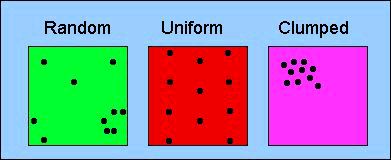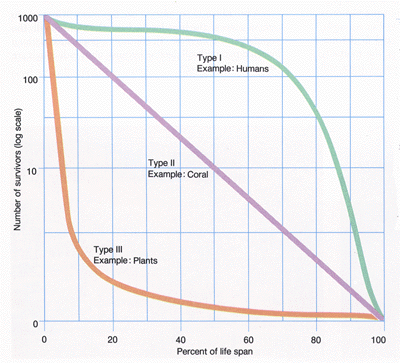Species - Group of organisms that interbreed in nature to produce fertile offspring.
Population - Group of individuals of one species living in the same area.
Community - Group of populations living in the same area.
Habitat - Place where an organism lives; includes biotic and abiotic factors in the area.
Niche - Biotic and abiotic resources used by an organism.
Size - Number of individuals in a population (N)
Density - Number of individuals in an area or volume
Dispersion - How individuals are spaced; clumped (in patches around resources such as cities), uniform (spread evenly, usually for defense), or random (trees in a forest).

Source: "Dispersion." . N.p., n.d. Web. 25 Apr. 2014. .
Survivorship Curves help show birth and death rates. There are 3 types: I, II and III.

Type I curves are organisms whose mortality increases after middle age such as humans. Type II are organisms whose chance of death is the same at any age (rodents). Type III are organisms that typically die young and few survive such as fish or oysters.
Source: "Survivorship Rates." Yesitisyomomma's Blog. N.p., n.d. Web. 25 Apr. 2014. .
Exponential growth is growth under ideal conditions without a carrying capacity. This creates a J curve but resources are usually limited and prevent this from occurring.
r = (birth - death)/N
Exponential growth is expressed as: dN/dt = r(max)N
Logistic growth shows how population growth slows are carrying capacity is approached. This creates a S-shaped or sigmoid curve. Carrying capacity is the maximum number of individuals an environment can support based on resources. As a population grows many factors begin to increase that may slow growth. These are called density-dependent factors and include disease, competition, waste products, predation. Density-independent factors can limit growth but do not depend on the size of the population such as natural disaters.
Logistic growth is expressed as: dN/dt = r(max)N(K-N)/K